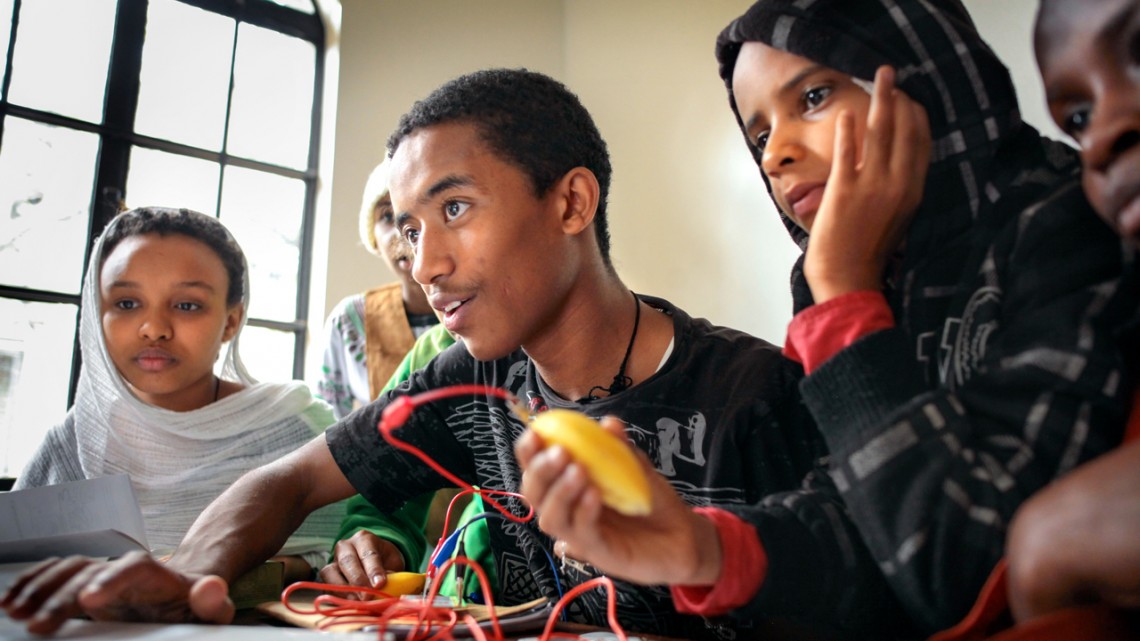
In a Kenyan refugee camp, a teenaged Burundian boy, a Somali boy and two girls from the Dinka ethnic group in South Sudan worked together to create a rudimentary video game about malaria.
The girls suggested the players’ goal should be indigenous plant medicine; the Somali boy said they should instead seek pills, since plant medicine is “old-fashioned.”
The others eventually agreed with him, and their resulting design depicted characters trying to avoid mosquitoes and reach little red pills. The teens’ collaboration, disagreement and finished product illustrated some of the opportunities and challenges of computational education, which can break down and expose cultural barriers in unexpected ways, a new study from Cornell University researchers has found.
“Friction is not just a source of conflict – it’s a source of learning,” said Ian Arawjo, doctoral student in the field of information science and first author of “Computing Education for Intercultural Learning: Lessons From the Nairobi Play Project,” which won an honorable mention for best paper at the upcoming Association for Computing Machinery Conference on Computer-Supported Cooperative Work and Social Computing, Nov. 9-13 in Austin, Texas.
The paper was co-authored by Ariam Mogos of the Nairobi Play Project; Steven Jackson, associate professor and chair of the Department of Information Science; Tapan Parikh, associate professor at Cornell Tech; and Kentaro Toyama of the University of Michigan.
The Nairobi Play Project, funded by the United Nations Children’s Fund Kenya Country Program, seeks to foster intercultural learning between groups in or at risk of conflict. In 30 after-school sessions led by teachers who are themselves refugees, students learn basic computing concepts and develop video games with community-based themes.
The perceived importance of computing, the novelty of the devices, the need to share equipment, unfamiliar modes of thinking and opportunity for laughter are among the factors that contribute to intercultural cooperation, Arawjo said. Many students – whose regular classes in refugee camps have student-teacher ratios of around 100 to 1 – said they likely wouldn’t have been allowed to participate in any other kind of class.
“My mother is OK with [the class] because I am the first person in the family using a computer,” a Somali girl told interviewers.
For the study, researchers observed classes, interviewed teachers and students and conducted surveys both before and after the program. They found that despite resistance – or in some cases, because of it – the structure of the computational class enabled unlikely friendships between students from very different backgrounds.
For example, a Somali girl initially expressed resistance to working with a South Sudanese boy, but said he “was my computermate and become my best friend” after the two shared a laptop for a month. A Congolese boy and a Sudanese boy bonded over language difficulties. Two Dinka students stopped attending the class after learning their teacher was from the Nuer tribe, because their two tribes were in active conflict. The teacher visited the boys to encourage them to return and finish the program, which they did.
The limited number of devices meant the students had to sit together and cooperate. When asked how he made friends from different backgrounds, a boy said, “Our teacher told us you must sit together – for example, you’re Congolese, you’re Sudanese. They mix us. … We have to communicate. Because there is only one computer. You cannot make something without the computer.”
Programming requires students to consider a problem from the computer’s perspective – similar to seeing from other people’s points of view, Arawjo said. Teachers built on these connections. Unfamiliar tools and debugging programs also tended to inspire humor, the researchers wrote.
A teacher demonstrates computational tools to students in the Nairobi Play Project.
“One thing that emerged from this work is that the line between computational learning and intercultural learning is not so clear,” Arawjo said.
None of these connections happened automatically. The researchers found that, as in the United States, cultural power hierarchies could be reproduced if teachers didn’t recognize and avert them. Teachers needed to be capable and experienced enough to take advantage of opportunities for intercultural learning. And the devices could distract the students, especially if the internet was available.
Teachers also faced the challenge of conflicts erupting in class. One cross-cultural team of boys created a video game in which migrants reclaim their lands by killing all male members of another tribe; concerned about reinforcing xenophobia, the teachers encouraged them to find another solution.
“Conflict is present,” Arawjo said. “But it also can be resolved, and the resolution of conflict offers powerful opportunities for learning.”

